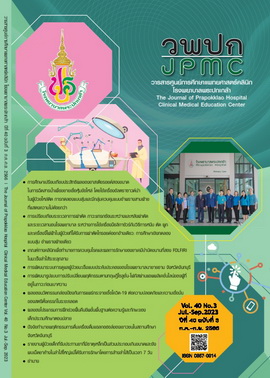Predictors of Alcohol Drinking Behavior of Youths in Educational Institutions Chanthaburi Province
Main Article Content
Abstract
BACKGROUND: Alcohol consumption is a significant problem for social and healthcare systems, Drinking may lead to insanity, violence, accident, and fatalities.
OBJECTIVE: This research aimed to study predictive factors of alcohol drinking behavior among youths in educational institutions in Chanthaburi province.
METHODS: This research was cross-sectional, predictive correlational research design. The sample consisted of 690 youths in educational institutions in Chanthaburi province, using a 3-stratified cluster random sampling. This research collected data by using questionnaires between February and March 2023. Data were analyzed by using descriptive statistics, correlation, and multiple linear regression.
RESULTS: This research showed that 330 (47.8%) of the youths in educational institutions drank alcohol, 173 females (52.4%) and 157 males (47.6%). Most alcohol-drinking behaviors were low-risk (60.6%). The sample group started drinking alcohol for the first time on average at 14.5 years; the youngest was 10 years old, and the oldest was 19 years old. Correlation analysis among the variables found that the age factor when first drinking alcohol, recognizing the benefits and harms of alcohol, attitude to drinking behaviors, the influence of close people and the media, and self-efficacy to control behavior were associated with alcohol drinking behavior. The correlation was 0.57, -0.31, 0.12, 0.49, and -0.28, respectively, with a significance of 0.01. Factors predicting alcohol drinking behavior among youths in educational institutions in Chanthaburi province were at 40.8 (R2=0.408). The age factor when first drinking alcohol (β=0.40, p<0.001), the influence of close people and the media (β=0.27, p<0.001), and self-efficacy to control behavior were associated with alcohol drinking (β=-0.14, p<0.001). The prediction equation: drinking alcohol=0.41, starting age to drink +0.27, the influence of close people and media –0.14, recognizing the benefits and harms of alcohol.
CONCLUSIONS: The results of this study provide a basis for developing an awareness-raising program or activity about the benefits and harms of alcohol use and strengthening youth and friends by focusing on 10-15 years old to prevent alcohol onset at an early age.
Article Details

This work is licensed under a Creative Commons Attribution-NonCommercial-NoDerivatives 4.0 International License.
References
World Health Organization. Global status report on alcohol and health. [Internet]. 2018 [cited 2022 Oct 20]. Available from: https://apps.who.int/iris/bitstream/handle/10665/274603/9789241565639-eng.pdf
National Statistical Office. The 2021 health behavior of population survey [Internet]. 2021 [cited 2022 Oct 20]. Available from: http://www.nso.go.th/sites/2014/DocLib13/ด้านสังคม/สาขาสุขภาพ/สำรวจพฤติกรรมด้านสุขภาพของประชากร/2564/report_2501_64.pdf
Thailand 2021 Fact Sheet.Global school-based student health survey [internet]. 2021. [cited 2023 Jan 1]. Available from:https://cdn.who.int/media/docs/default-source/ncds/2021-thailand-gshs-fact-sheet.pdf
Health Data Center (HDC).People aged 15 years and over in the responsible area were screened for alcohol drinking behavior (Coverage) in Chanthaburi province, fiscal year 2023. [internet]. 2022 [cited 2023 Jan 1]. Available from: https://cti.hdc.moph.go.th/hdc/reports/report.phpcat_id=06b9ffbd9fa83f29fef3a7e7ba8119d6&id=fca1c097386905e35cd4d4113347a293
Pretsuk R. Factors predictingthe intention to alcohol consumption of Suan Dusit Rajabhat University Students in Bangkok Province.Christian University Journal 2014:20:250-9.
Prayongkul P, Thaweekoon T, Sangon S. Factors predicting intention of alcohol consumption behavior in secondary school students.Thai Red Cross Nursing Journal 2018:11(2):219-35.
AjzenI.The theoryof planned behavior.Organization behavior and human decision Process 1991:50:179-211.
Chanthaburi Trad Secondary Education Seviced Area Office. Basic information [internet]. 2022 [cited 2023 May 1]. Available from: http://www.sesact.go.th/index.php/lo2076ez8749zz
World Health Organization. The alcohol use disorders identification test: guidelines for use in primary care. 2nded. Department of mental health and substance dependence.Ministry of Public Health Office; 2001.
Onmoy P, Junrith K,Factors associated with alcohol access and drinking behavior of adolescents in Uttaradit province. Journal of Health Science 2020:29:590-600
Sootthasil M,ChaleoykittiS.Factors influencing alcohol drinking behavior among students Valaya Alonghorn Rajabhat University Under Royal Patronage. RTA Med J 2018:71:23-33
Chaikan A, Chaikan A. Alcohol drinking behaviors among undergraduate students of Phranakorn Si Ayutthaya Rajabhat University, Phranakorn Si Ayutthaya Province. Valaya Alongkorn Review (Humanities and Social Science) 2017:7(1):103-13.
Luxsiam N, Watthayu N, Rattanathanya D. Factors predicting alcohol drinking behavior among adolescent students in Surin Municipality. Journal of Nursing and Health Care 2019:37(4):22-31.
Tonpongrungi R, Homsin P, Srisuriyawet R .Factors related to binge drinking among male vocational students in Surin province. Journal of Public Health Nursing 2016:29(1):29-42.
PiyapanW, Srisuriyawet R,Homsin P.Predictive factors of intention to engage in risky drinking among male vocational student in ChaiNatprovince.The Journal of Faculty of NursingBurapha University 2017:24(2):85-96.

